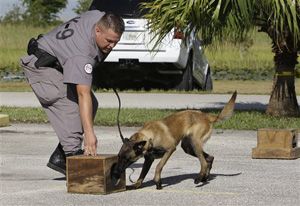If the will of the mind is not in the fight, then the fight will not last long.
Co-Authored by Derek Applegate, Canine Supervisor, Lexington, South Carolina County Sheriff’s Office
No matter how tough we think we are, psychologically healthy humans have an innate fear of being bitten or attacked by an animal — in many cases a dog. It doesn’t matter if it’s a poodle or pit bull; any dog bite can cause significant injury. The use of canine in a correctional setting combines the best of both factors of mental and physical weapons into one: Canines have a way changing the minds, and ultimately the actions of inmates.
 K9 Inspector Freddie Long works with the dog Razor as he searches for cell phones hidden in a box during a demonstration at the Broward Correctional Institution in Ft. Lauderdale, Fla. Oct. 7, 2008. Razor has been trained to sniff out the devices. (AP Photo/Lynne Sladky) |
Whether the canine is wearing a muzzle or held closely on a leash by their handler, a trained dog acts as a significant force multiplier. The fact that a canine is present in the same room can modify the way inmates behave and even respond when showing verbal or physical resistance to officers. This effect is a valuable psychological commodity in environments where officers are badly outnumbered by inmates.
Agencies may be hesitant to bring canine into their facilities for a number of reasons, most having to do with liability. But with the proper training (for both man and dog), canine can be a very effective use-of-force tool — a tool that can increase the safety of both the officers and inmates.
Canine as a support team
If you are a CERT or SORT mini-team, canine will allow you to control a few variables and provide your team of officers with addition protection and cover.
When making an entry through a doorway of a recreation yard, library or housing area, a canine placed at the door entrance will enable you to secure this location in case your front line officers are over-powered. Once the front doorway area is secured, bringing the canine into the immediate area where the inmates can get a good visual on the canine and handler will show support for your front line officers.
Canine are also great for helping squad personnel secure their flanks; when in a wedged formation, holding a canine on a short lead (5 foot or less) will help provide a positive visual deterrent while moving through a crowd.
Like all non-lethal weapons, canines offer a variety of benefits. However, these benefits require a high level of training to ensure proficiency. Using canine inside your facilities will help with creating many different types of ruses, tactical strategies and distractions that you would not otherwise have. But in the same way that inmates know the limitations of chemical and electronic non-lethal weapons (e.g., distance), they will come to know the limitations of canines, as well.
I recommend that you deploy your canines into your facilities on a semi-regular basis to support your mini-teams. Start out by letting the inmates see the canines, then every now and then let them hear them barking; gradually let the inmates see them moving at the entrances, and exits, then slowly next to your non-lethal shooters, then behind the mini-teams on your front line. And then, when needed, allow the inmates to experience the canines moving between the front lines to lightly engage some of the most combative among them. This slow but steady build-up may take a few years to a few months, based on the level of disobedience. Within the walls of a correctional facility, it is often just a case of setting the stage to establish who is in control.
The use of canines are recommended for but not limited to:
- A non-lethal force option
- In support of your mini-teams
- An addition to your force options
- To save the life of an officer or inmate
- To protect the public
- Prevent and or stop an escape
- Rescue an officer or inmate
- Controlled escort of inmate activity
Canines should never — and I mean never — be used as:
- A form of punishment
- Unlawful harassment
- A means of interrogation
Training of canines for correctional institutions
As with all use-of-force options, training will play an important part in the mission’s readiness and success. There are many types of police service dogs (PSD), and not all dogs are created equal. You as the handler or trainer should first determine if your PSD is right for working in a correctional facility. Many PSD are not ready to be a SWAT PSD, working with a CERT or SORT is very similar. There is no shame for any handler or trainer to recognize their particular PSD limitations.
Also read: Canine tracking offered at mock prison riot












